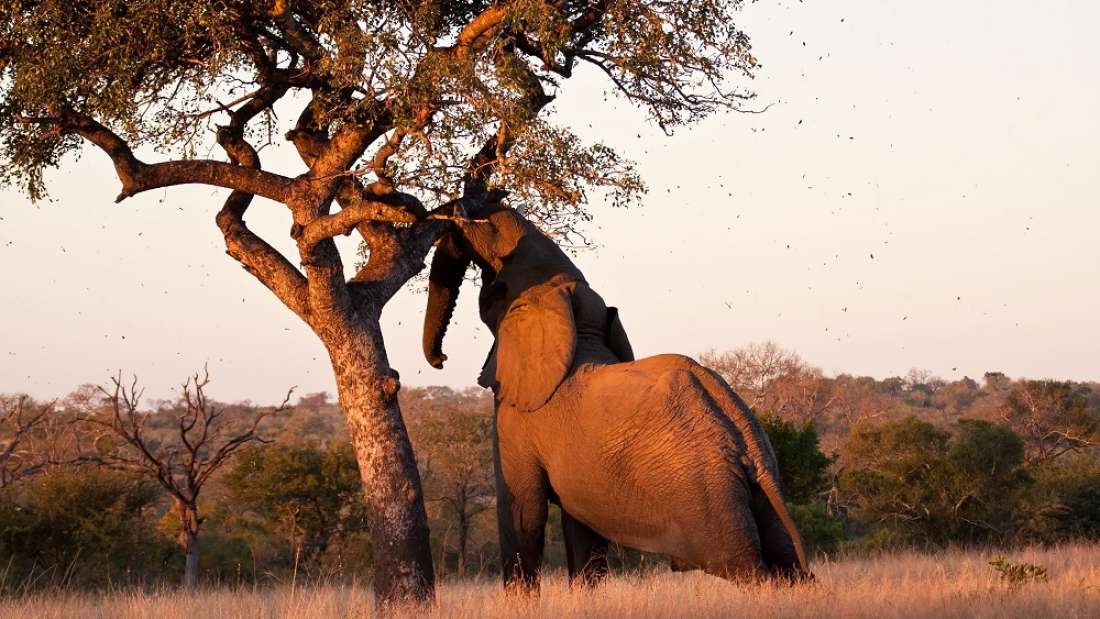一头大象走进酒吧,它会喝醉吗?
一头大象走进酒吧,它会喝醉吗?
As early as the 19th century, elephants have had a bit of a reputation for getting “drunk” from the fruit of the marula tree in Africa. Whilst various studies have questioned these stories due to the volume of fruit they’d need to consume, other animals have also reportedly been found inebriated (from raccoons to bees).
早在19世纪,大象就因吃了非洲的马鲁拉树的果实而有点“喝醉”的名声。虽然各种各样的研究对这些故事提出了质疑,因为它们需要消耗大量的水果,但据报道,其他动物也被发现醉酒(从浣熊到蜜蜂)。
To provide some insight into these tipsy tales, a team of researchers have looked into the genetic variations of the ADH7 gene of 85 mammals, as previous studies have linked mutations in the gene with the ability of a species to metabolize ethanol – the form of alcohol contained in beverages and that also naturally occurs from the fermentation of fruit sugars.
为了深入了解这些荒诞的故事,一组研究人员研究了85种哺乳动物ADH7基因的遗传变异,因为之前的研究已经将该基因的突变与一个物种代谢乙醇的能力联系起来,采用在饮料中所含的酒精的形式,它也自然地发生在水果糖的发酵过程中。

Katy Pallister
“We focused on the ADH7 gene because previous research (led by co-author Dr Matthew Carrigan) had found that humans have a mutation in this gene that makes the protein 40 times more efficient at metabolizing ethanol,” Dr Mareike Janiak, a corresponding author of the study from the University of Calgary, Canada, told IFLScience. “This evolved around 10 million years ago in our common ancestor with chimpanzees and gorillas, potentially as an adaptation for eating fruit.”
“我们之所以关注ADH7基因,是因为之前的研究(由合著者马修·卡里根博士领导)发现,人类的这种基因发生了突变,使得这种蛋白质代谢乙醇的效率提高了40倍。”加拿大卡尔加里大学的通讯作者Mareike Janiak博士告诉IFLScience。“这是大约1000万年前在我们与黑猩猩和大猩猩的共同祖先身上进化而来的,可能是为了适应吃水果。”
Curious as to whether these mutations were found in other mammals, Janiak and her colleagues mined data on the genomes of 85 species, across 21 orders, and with a variety of diets. One of the hypotheses the team were interested in was whether a diet high in fruit resulted in the selection on the ADH7 gene, seen in humans, to help them more readily metabolize ethanol. The team found the ADH7 gene sequences in 79 of the 85 mammals they investigated.
出于对是否在其他哺乳动物身上也发现了这些突变的好奇,Janiak和她的同事们对85个物种的基因组数据进行了挖掘。研究小组感兴趣的一个假设是,富含水果的饮食是否会导致人类体内ADH7基因的选择,从而帮助他们更容易地代谢乙醇。研究小组在他们调查的85只哺乳动物中发现了79只的ADH7基因序列。
“We found that many mammals that eat mostly meat or leaves actually didn’t have a functional ADH7 gene and they may have lost this gene because of the lack of fruit in their diet,” Janiak explained. However, some animals such as fruit and nectar bats, whose natural diet contains at least some ethanol, may have acquired the same human change in ADH7 to prevent them being “drunk and disorderly.”
Janiak解释说:“我们发现,许多以肉类或树叶为主要食物的哺乳动物实际上并没有一种功能性的ADH7基因,它们可能因为饮食中缺乏水果而失去了这种基因。”然而,一些动物,如水果和花蜜蝙蝠,它们的自然饮食中至少含有一些乙醇,可能已经在ADH7中发生了与人类相同的变化,以防止它们“醉酒和混乱”。
“Being inebriated would be especially bad news for a flying mammal, so being able to better metabolize ethanol could be an important adaptation,” Janiak remarked.
“对于飞行中的哺乳动物来说,醉酒尤其是个坏消息,所以能够更好地代谢酒精可能是一个重要的适应过程,”Janiak说。
Although it may not feel like it after a big night out, humans are up there with other African great apes as one of the mammals capable of quickly metabolizing ethanol. Others include aye-ayes, a primate found in Madagascar who are known to drink nectar, and koalas, whose eucalyptus diet contains a lot of toxins.
尽管在一夜狂欢之后可能感觉不到,但人类和其他非洲类人猿一样,是能够快速代谢乙醇的哺乳动物之一。其他动物包括在马达加斯加发现的一种叫aye-ayes的灵长类动物,它们以喝花蜜而闻名,还有考拉,它们的桉树食物含有大量毒素。
At the other end of the scale are those species who no longer have a functional ADH7 gene, Janiak explained. This includes bovids, carnivores, some rodents such as guinea pigs, dolphins, whales, and our old friends elephants. “Many of these species just don’t consume fruit, fresh or rotten, so they’re probably rarely exposed to ethanol,” Janiak said. “But anecdotes about elephants and horses eating rotting fruit are common.”
Janiak解释说,在天平的另一端是那些不再具有功能性ADH7基因的物种。这包括bovids,食肉动物,一些啮齿类动物,如豚鼠,海豚,鲸鱼,和我们的老朋友大象。Janiak说:“这些物种中的许多只是不吃新鲜或腐烂的水果,所以他们可能很少接触到乙醇。但关于大象和马吃腐烂水果的轶事很常见。”
Whilst the lack of a functional ADH7 gene would make it easier for an animal to become inebriated, one of the study’s conclusions, published in Biology Letters, pointed out the tendency of humans to anthropomorphize animal behavior – likening an animal’s innocent unsteadiness to our drunken sways. Therefore, each story of animal intoxication should take into consideration each species’ unique physiology, rather than referring to human's drunken experiences, the authors warn.
虽然缺乏功能性的ADH7基因会使动物更容易醉酒,但发表在《生物学快报》上的一项研究结论指出,人类倾向于将动物行为拟人化——将动物的天真不稳定比作我们醉酒后的摇摆。因此,作者警告说,每一个动物中毒的故事都应该考虑到每个物种独特的生理机能,而不是参考人类的醉酒经历。
Probably for the best – I'm not sure an elephant flailing round a pole in the middle of a club would end well.
也许这是最好的结果——我不确定一头大象在棍子中间绕着一根杆子打转会有什么好结果。


















